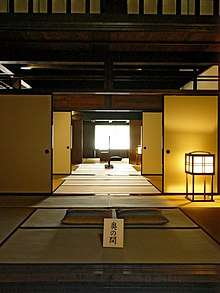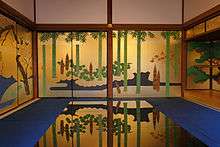Fusuma
In Japanese architecture, fusuma (襖) are vertical rectangular panels which can slide from side to side to redefine spaces within a room, or act as doors.[1] They typically measure about 90 centimetres (3.0 ft) wide by 180 centimetres (5.9 ft) tall, the same size as a tatami mat, and are two or three centimeters thick. The heights of fusuma have increased in recent years due to an increase in average height of the Japanese population, and a 190 centimetres (6.2 ft) height is now common. In older constructions, they are as small as 170 cm (5 ft 7 in) high. They consist of a lattice-like wooden understructure covered in cardboard and a layer of paper or cloth on both sides. They typically have a black lacquer border and a round finger catch.


Historically, fusuma were painted, often with scenes from nature such as mountains, forests or animals. Today, many feature plain mulberry paper, or have industrially printed graphics of fans, autumn leaves, cherry blossom, trees, or geometric graphics. Patterns for children featuring popular characters can also be purchased.
Both fusuma and shōji (sheer, translucent paper room dividers) run on wooden rails at the top and bottom. The upper rail is called a kamoi (鴨居, lit. "duck's place"), and the lower is called a shikii (敷居). Traditionally these were waxed, but nowadays they usually have a vinyl lubricating strip to ease movement of the fusuma and shōji.
Along with the fusuma, shōji and tatami straw mats (as the floor) make up a typical Japanese room.
References
- MATCHA. "Fusuma (Sliding Doors) - Japanese Encyclopedia". MATCHA - JAPAN TRAVEL WEB MAGAZINE. Retrieved 2020-02-02.
External links

- English site explaining all about fusuma, with diagrams and photos
- Momoyama, Japanese Art in the Age of Grandeur, an exhibition catalog from The Metropolitan Museum of Art (fully available online as PDF), which contains material on fusuma